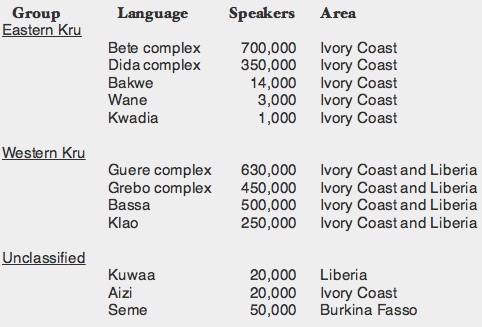An insatiable appetite for ancient and modern tongues


Overview and Distribution. Kru languages constitute a small family within the very large Niger-Congo phylum. Spoken by about 3 million people in the forest regions of southern Liberia and south-west Ivory Coast, they were one of the first African languages met by Europeans, though only recently they have been systematically studied.
External Classification: Niger-Congo, Volta-Congo, Kru.

Internal Classification:
Kru languages are divided into Eastern and Western groups plus some isolates.
Oldest Documents
-A Kru word list appeared in Language de Guynée, a French manuscript of 1540.
-A few Kru languages were included in W. Koelle’s Polyglotta Africana published in 1854.
SHARED FEATURES
-
✦ Phonology
-
-Vowel system: The typical vowel system of Kru languages has four front vowels, four back vowels and a central one.
-
-Vowel harmony: In Kru languages there is a contrast between vowels pronounced with an advanced tongue root (+ATR) and a retracted tongue root (-ATR): only vowels from (+ATR) set or from (-ATR) set appear in the same morpheme.
-
-Consonants. Stops are articulated at five different points: bilabial, alveolar, palatal, velar and labio-velar.
-
-Tones: Kru languages have three or four tones which serve to make lexical or grammatical distinctions (number, definiteness, verbal aspect).
-
-Syllables: Open syllables (ending in a vowel) are predominant. Most words are monosyllabic or disyllabic.
-
✦ Morphology
-
-Many grammatical features, like plurality and aspect, are marked by suffixes.
-
-In some Kru languages there are remnants of a noun-class system similar to that of Bantu languages except that in them suffixes are used instead of prefixes.
-
-The verbal system is based more on aspect than tense. Imperfective and perfective are marked by suffixes; progressive, perfect and conditional are often marked by an auxiliary verb.
-
✦ Syntax
-
- The basic word order is Subject-Verb-Object (SVO), but when an auxiliary verb is present it changes to S-AUX-O-V.
-
-Noun-modifiers (adjectives, articles, etc) usually follow their heads and direction is indicated by body parts placed also after the noun. In contrast, possessives and genitives precede their nouns.
-
© 2013 Alejandro Gutman and Beatriz Avanzati
Further Reading
-
-Languages of Africa. J H. Greenberg. Mouton (1963).
-
-'Niger-Congo'. K. Williamson & R. Blench. In African Languages, 24-25. B. Heine & D. Nurse (eds). Cambridge University Press (2000).
-
-'Kru'. L. Marchese. In The Niger-Congo Languages, 178–215. J. Bendor-Samuel (ed). University Press of America (1989).
-
-'Kru Languages'. J. Bendor-Samuel. In Concise Encyclopedia of Languages of the World, 623-625. K. Brown & S. Ogilvie (eds). Elsevier (2009).
Kru Languages

Address comments and questions to: gutman37@yahoo.com
MAIN LANGUAGE FAMILIES
LANGUAGE AREAS
Languages of Ethiopia & Eritrea
LANGUAGES by COUNTRY
LANGUAGE MAPS
-
• America
-
• Asia
-
Countries & Regions
-
-
Families
-
• Europe
-
• Oceania